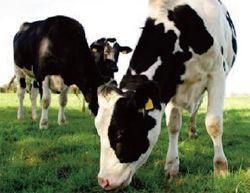Over the past few months we have had numerous enquiries from contractors and farmers in relation to the problems caused by stray voltages in Milking Parlours.

This whole problem is a source of great worry and cost to the Dairy Farming Community since the presence of stray voltages causes distress to cows, who are reluctant to go into the parlour, constantly move around while milking, fail to milk out fully and bolt from the parlour when released.
More seriously however, the stress caused by stray voltage leads to significantly increased somatic cell count in the milk, which will either be rejected by the processer to whom the farmer supplies, or will incur substantial fines or prices reductions.
The stray voltages in a parlour may be either pure AC, pure DC, or a combination where both are present.
A contractor called to deal with this problem should immediately establish the type of voltage present as both are caused by completely different circumstances.
Stray AC voltage generally comes as a result of bad bonding and earthing, a high incoming ESB neutral, insufficient cross section of the neutral conductor, or the fact that the earth bars of a mains operated electric fence are placed too close to the main earth of the parlour installation, or too close to one or more of the ESB pole earths between the transformer and the building.
The elimination of these sources of AC should be relatively simple by ensuring that bonding and earthing are checked and improved if necessary and by ensuring that no mains operated fence earths are too close to the supply earths.
DC Voltage creates a far greater problem and it is more likely to be found in parlours constructed in recent years where the tendency to add chemical additives to concrete became much more prevalent.
These additives bring about a chemical reaction between the concrete and the re-bars in the under floor mesh.
The reaction, which is referred to as electro chemical generation, can produce voltages of up to 1 volt DC between the re-bars and the concrete floor.
Since the under floor grid is connected to the tying rails and rump rails and in turn connected to all other metal in the parlour, it means that a DC Voltage is present between this metal and the concrete floor.
If a cow puts her nose or her tongue into a metal feed bowl she will complete the DC circuit between her tongue, which is in contact with one pole of the DC potential and her feet on the wet ground, which is at the opposite polarity.
The flow of DC current along this path through the animal’s body is most upsetting and leads to all the outward symptoms of stress listed earlier.
Elimination of the DC voltage is not easily achieved since the electro chemical generation can continue for years but there are some practical steps which can be taken to alleviate the problem.
Contractors who find themselves faced with the presence of DC in a Milking Parlour should contact ECSSA where we can discuss the options available and put them in touch with other contractors who have encountered the same problem and who may have resolved the issue in a variety of ways.
We also welcome feedback from contractors who have devised ways of dealing with what is a very serious problem for an important sector of our economy.
